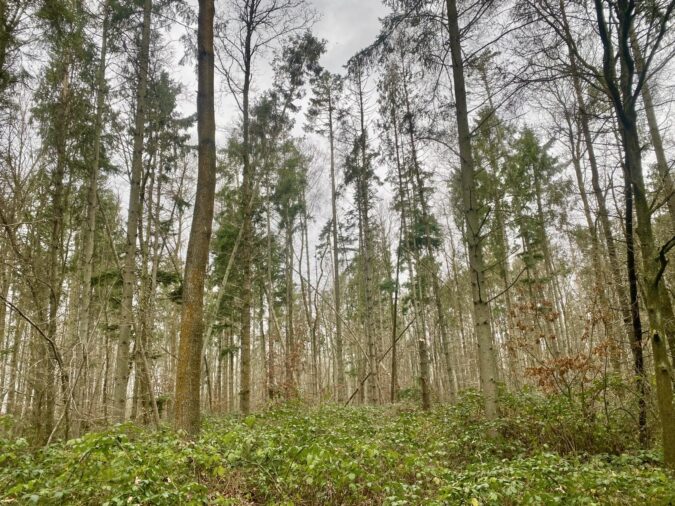With a little help from my friends ……

Plantations are generally monocultures of economically important tree species, trees that are valued for their timber and rapid growth. Compared to natural woodland, biodiversity is lower in monocultures. They are less resilient to extreme climatic events, attack by pests and/or disease and offer fewer ecosystems services. Adding different trees into the mix of species can result in an increase in biomass (timber) production and resilience. Since the 1930’s, a ‘nursing mixture’ of Pines and Sitka Spruce has been used to establish Sitka forest in nutrient-poor soils (without the use of fertilisers or herbicides). Quite how the pines benefited the growth of the Spruce was not known.
One possible ‘mechanism’ is plant soil feedback [PSF], where plants change the nutrient make-up and/or the bacterial and fungal community of the soil. These changes then benefit the subsequent growth of seedlings / saplings. Important in this respect are the fungi that can establish symbiotic / mycorrhizal associations with plant roots. Ectomycorrhizae (ECM) exist mainly as an external coating on the roots, with some of the hyphae penetrating into the root tissue. Ectomycorrhizae are often associated with woody tree species, particularly conifers.
There are a number of parts to a mycorrhizal association with trees:
- The Hartig net, this is the fungal hyphae that penetrate the roots of the tree, and make contact with the root cells, allowing for the exchange of carbon compounds, mineral nutrients, and water.
- The Mantle is the sheath of hyphae that covers the tree roots. It is a more substantive structure than the Hartig net. The fungal sheath probably offers some protection to the delicate root tips from pathogens and pests.
- The Extra-radical hyphae. These grow out from the mantle into the soil. They may spread a significant distance from the actual roots, increasing the surface area for the absorption of water and minerals.
- The Fruiting bodies. These are the reproductive structures of the fungus and are visible above ground.
Now some evidence is accumulating about how nursery mixtures / species have their effect. Last year, researchers at Manchester University looked at the nursing effect of pine and silver birch on Sitka Spruce. They collected soil from Cannock Chase, where these tree species co-existed. The soil was sieved and some sand added and then placed in pots. Four groups of pots were created
- Pots with pine seedlings
- Pots with Spruce seedlings
- Pots with silver birch seedlings
- Pots with all three types of seedlings
| Pot Treatment | Species grown in the conditioned soil | |||
| Pine conditioned soil | Pine | Spruce | Birch | |
| Spruce conditioned soil | Pine | Spruce | Birch | |
| Birch conditioned soil | Pine | Spruce | Birch | |
| Pine, Spruce & Birch conditioned soil | Pine | Spruce | Birch | |
All the pots were placed in a greenhouse and the seedlings allowed to grow on for 34 weeks. This allowed the growing seedlings to ‘condition’ the soil. At the end of this time, the seedlings were removed and soil sieved and placed in fresh pots. The four ‘types’ of ‘conditioned’ soil were then used to grow on newly germinated seeds of the three tree species. One seedling was grown per pot, and the pots grown on for 24 weeks in the greenhouse again.
At the end of the 24 weeks, the seedlings from each pot were harvested and carefully examined. For each, many features were recorded
- Root length
- Branching intensity
- Root tissue density
- Total root length
- dry weight /mass recorded
- Ectomycorrhizal colonisation (microscopic analysis)
- Specific leaf area
- VIII.Leaf dry matter
- Photosynthetic rate
The soil was also subjected to detailed analysis (e.g : pH, nitrates, microbial enzymes etc).
The results showed that
- The Spruce seedlings grew best in the soil that had been previously ‘conditioned’ with Pine growing in it.
- The Spruce fared less well in the previously Spruce ‘conditioned’ soil
- The increased growth was associated with greater root colonisation by mycorrhizae.
- Longer term increased growth in the silver birch ‘conditioned’ soil might be associated with increased availability of soil nitrates
It would seem that Pines facilitate the growth of the Spruce through the enhanced establishment of symbiotic, mycorrhizal connections. These connections allow saplings to access vital mineral nutrients such as phosphate. This study therefore goes some way to explaining the nursing effect of mixed species planting.

Full details of this work may be accessed here :
https://besjournals.onlinelibrary.wiley.com/doi/10.1111/1365-2664.14848
Comments are closed for this post.
